We get it, abstract writing is hard.
Writing a great abstract requires condensing a lot of key info about your study into a very short space while convincing a reader to read your paper.
Yikes.
The good news is that simply learning to diagnose and fix these 6 common abstract mistakes will already elevate your abstract and make it clear to your reader why your work is important and deserves to be published!
BUT, most abstracts make at least one!
So if you make any of these mistakes in your abstract writing, don’t worry, you’ll learn exactly how to fix them!
Watch to improve your abstract writing!
1. Not including a relatable problem for reader
The abstract is first place we have to relate to our reader, and if we fail to do that right away, we miss a key opportunity to attract readers to our paper.
At the beginning of our abstract, we need to use 1 sentence, maybe 2, to put our work into context and show why it is important that work is done in this field. This is usually done by showing a problem in the field and why it should be solved.
To see what I mean, check out the example below colored according to this color scheme I’ll be using to guide you through these abstract mistakes. For a detailed description of these parts, where they go in an abstract, and why they go there, check out the abstract breakdown video!
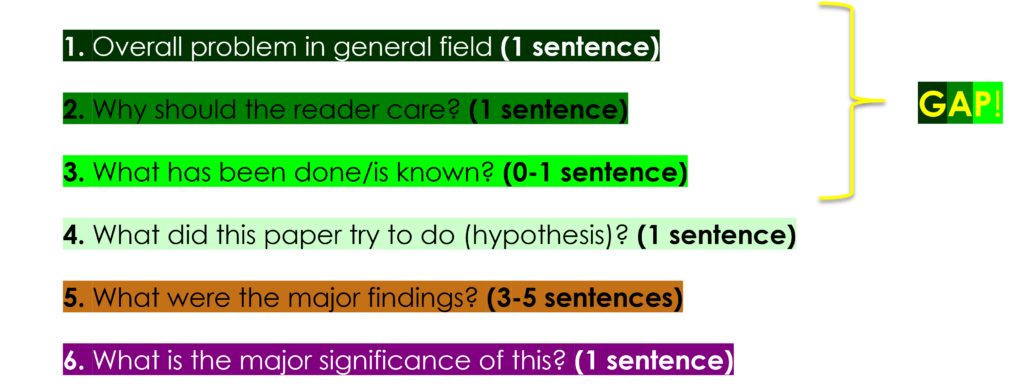
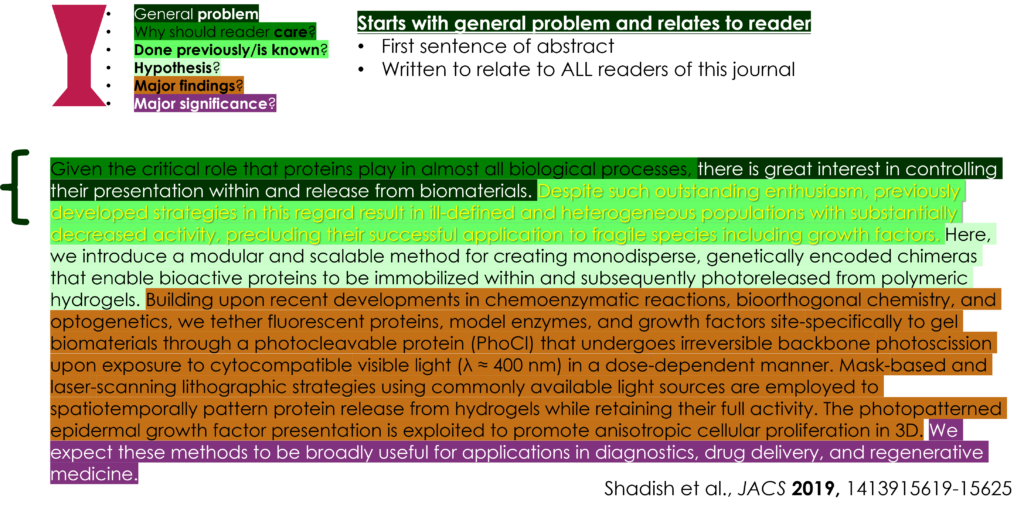
In this great example abstract taken from Shadish and friends (read it here!), notice that the VERY FIRST SENTENCE presents a problem general enough for the average reader to relate and provides some context as to why they should relate.
Perfect!
Now your reader knows how to place your work in context. Aka. how to tell if your work is important!
In cast, look at how the perception of this work changes when this sentence is missing:

Notice now how there is no CONTEXT as to why the reader should care that there is a lack of strategies for the process described here. So what? Why does this matter?
Your work is only going to matter as much as you can convince others that it does.
If you can’t convince an editor to publish it in a good journal, fewer people will see it. If you can’t relate to an average reader, fewer will open it.
So work to make your research relatable.
Abstract mistake #1: Not relating to reader. Use the first 1 sentence, maybe 2, to put work into context and show why work is needed in this field, or miss this key opportunity to attract readers. Your work only matters as much as you can convince others it does.
Kaycie at ButlerSciComm Tweet
2. Missing statement of impact
A reader of your abstract likely doesn’t know how important your contribution is to the field, so it is up to you to tell them.
In an abstract, you want to put this at the end – after you’ve already set up a problem and how your work addressed it.
Check out this final sentence:
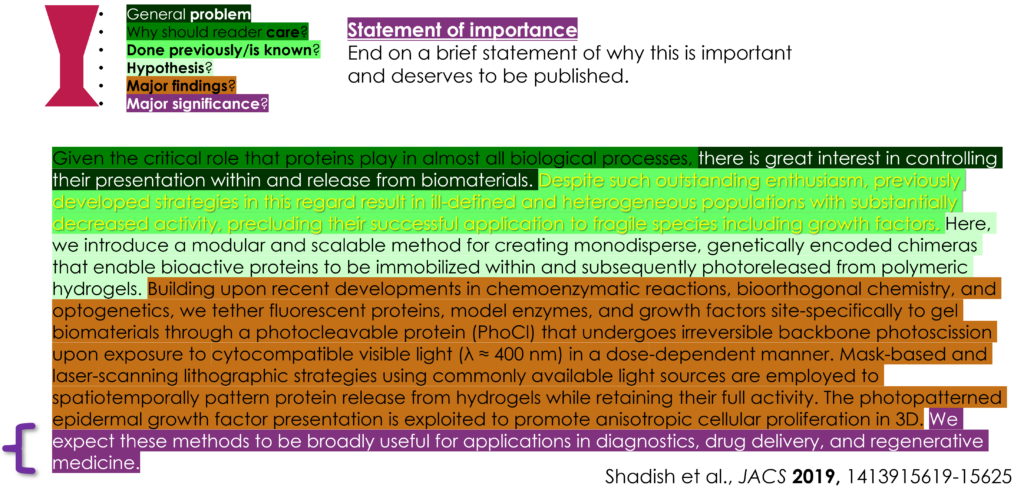
Notice how this sentence tells the reader:
- So what?!
- Why this work matters and deserves to be published
- Ties this work to the relatable problem at the beginning
It brings the abstract full circle and basically shows HOW your work affected the field.
Don’t believe me? See how the abstract reads when that statement is missing:
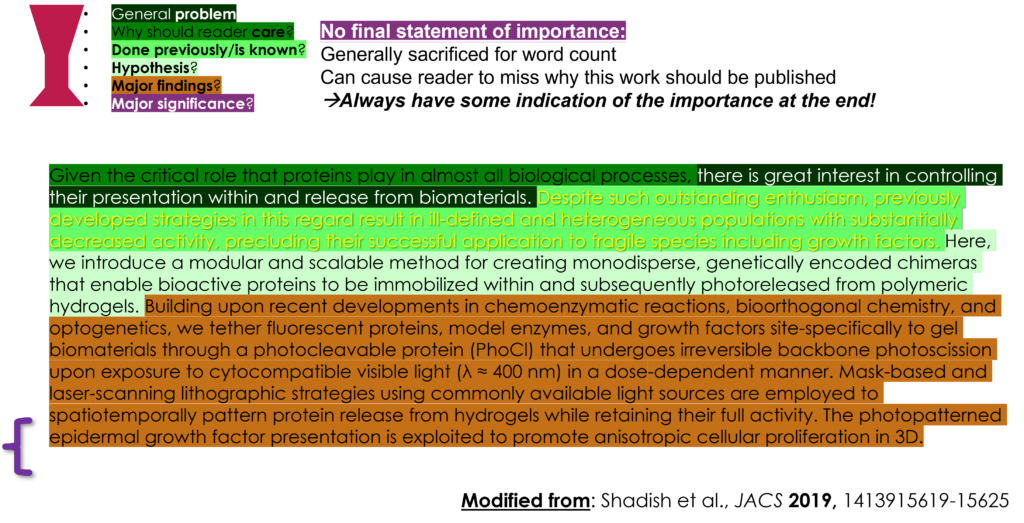
Notice here how different it feels…
- Abrupt, unsatisfying ending
- No indication of why this work matters
- Fails to bring abstract full circle
Abstract mistake #2: Missing statement of impact. If your abstract doesn't end with a one sentence summary of "So what? Why does my work matter?", your reader won't guess for themselves! Add this to indicate the impact of your work.
Kaycie at ButlerSciComm Tweet
3. Including too many results
An abstract is sometimes considered mainly a summary of the findings.
Notice, though, just how much more there is to an abstract.
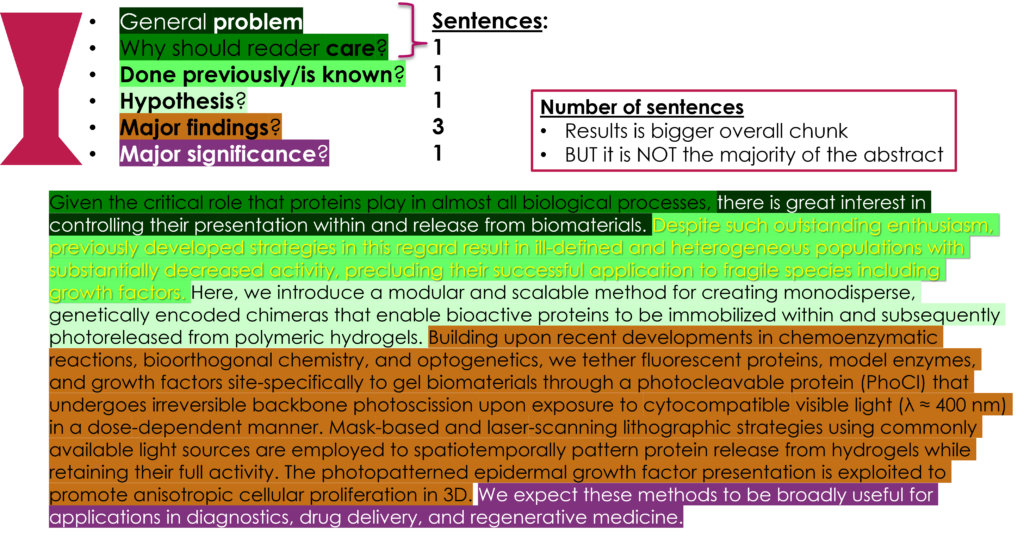
In this example, while summary of results is the biggest overall section, it really only makes up about half of the story.
And that’s just it – the results are just the results, but the abstract MUST also tell the STORY of your results, or a reader won’t be able to make sense of what you did and understand the implications of it.
See how the lack of supporting context can dramatically change the accessibility of this abstract:
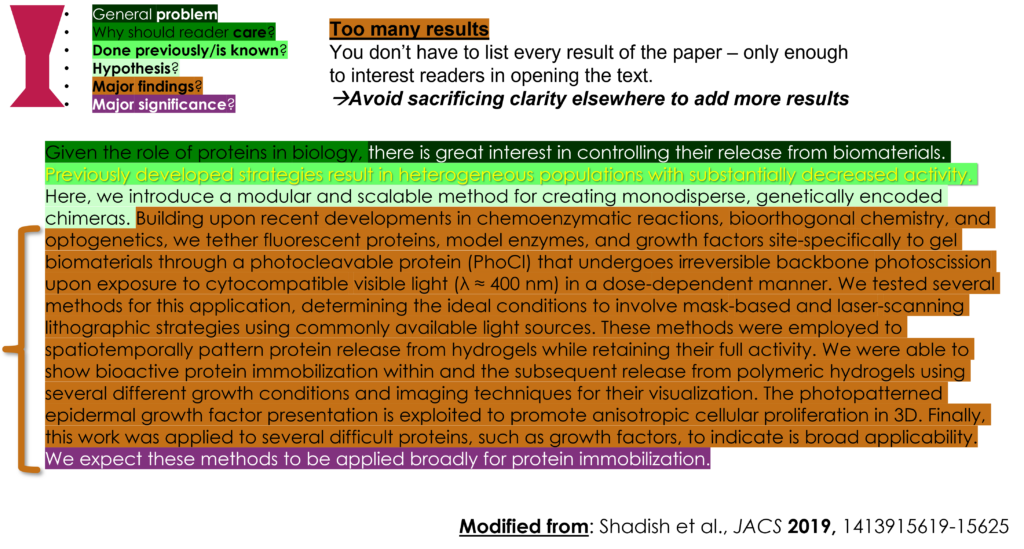
While this abstract does have text for each key part, the impact of this abstract is rather low, because the context is so, well… abstract… as to be completely uninformative.
Meaning your reader still doesn’t know why they should care about this problem and why this work matters.
Not good.
Keep your results to ~1/2 of your abstract, and fill in the rest with enough context for your reader to see the “story” behind WHY your work matters and deserves to be published.
Abstract mistake #3: Too many results w/o context. Results should only be ~half of your abstract. This just tells what you found - filling the space with results and not context means readers will miss the "story", and with that, why your work matters.
Kaycie at ButlerSciComm Tweet
4. Missing objective statement
A statement of the objective (or goal, hypothesis, aims, etc.) of your paper sets the scope of the paper for your reader – thus setting their expectations!
And when abstract writing is done properly, the positioning of this goal statement is also crucial, as it can DIRECTLY tell the reader the impact of this paper…
See if you can spot how (refresh yourself on the parts of an abstract):
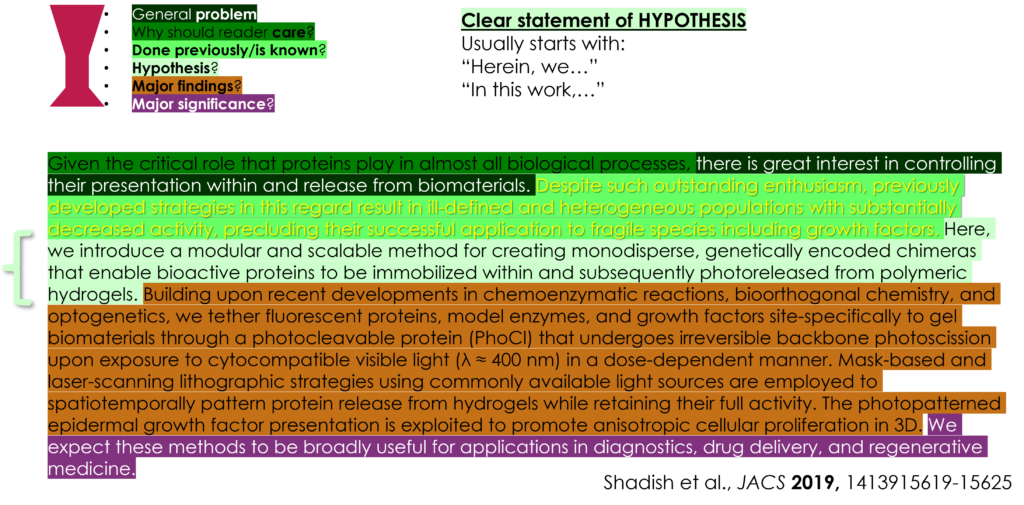
Did you notice what preceded the statement of the goal?
Hopefully you noticed that the objective followed our block of yellow text – representing the GAP in the field.
So our statement of our main objective in this paper directly followed a statement of what was missing in the field.
Meaning that this abstract is structured so that we tell the reader:
- A problem to care about
- A gap that still needs to be filled
- What we did to fill that gap
That flow right there DIRECTLY tells the reader the impact and importance of your paper.
Pretty cool, huh?
Don’t believe me?
Check out this abstract, and see how that flow changes:
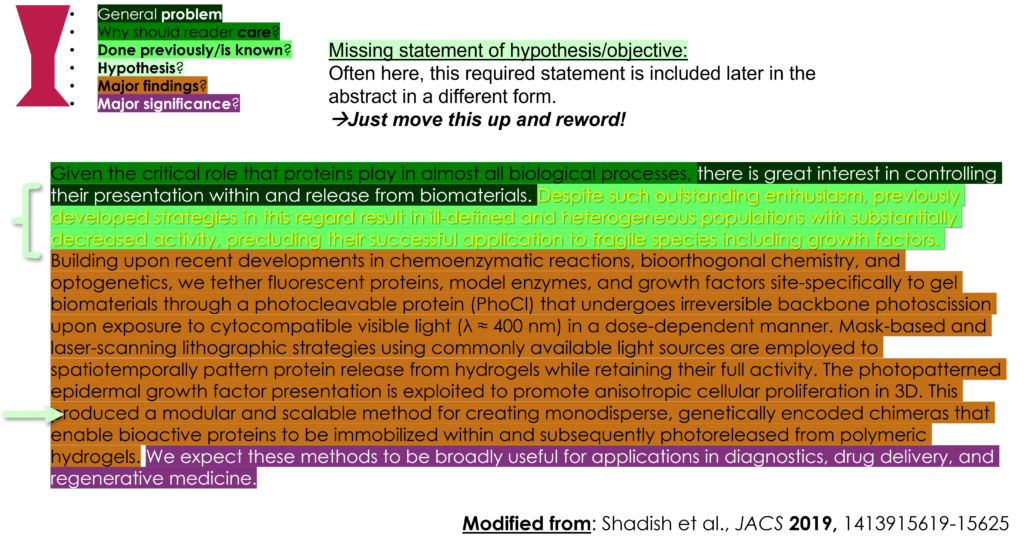
See how without the direct statement of the objective of this paper after the gap, the importance is no longer as clear.
But luckily, most papers that seem to lack this statement DO have it…its just buried in the results and worded to blend in.
Instead, just move this up and reword it using a statement like “Herein, we…” or “In this paper, we…” to make it clear this was your main goal.
Then, try to always put it directly after a direct statement of a research gap to make the importance of your work shine through!
Abstract mistake #4: Missing a goal/objective statement. This sentence sets the reader's expectations for your paper, and when it directly follows the problem and gap, also tells the reader the EXACT impact of your work!
Kaycie at ButlerSciComm Tweet
5. Missing direct statement of gap
Sometimes, abstracts skip a direct statement of the existing GAP in the literature that explains why the project needed to exist.
This structure expects the readers to figure it out for themselves, but that only works for experts in the field!
Instead, we need to spell out the research gap in no uncertain terms, and do it directly in the abstract.
What does that look like?
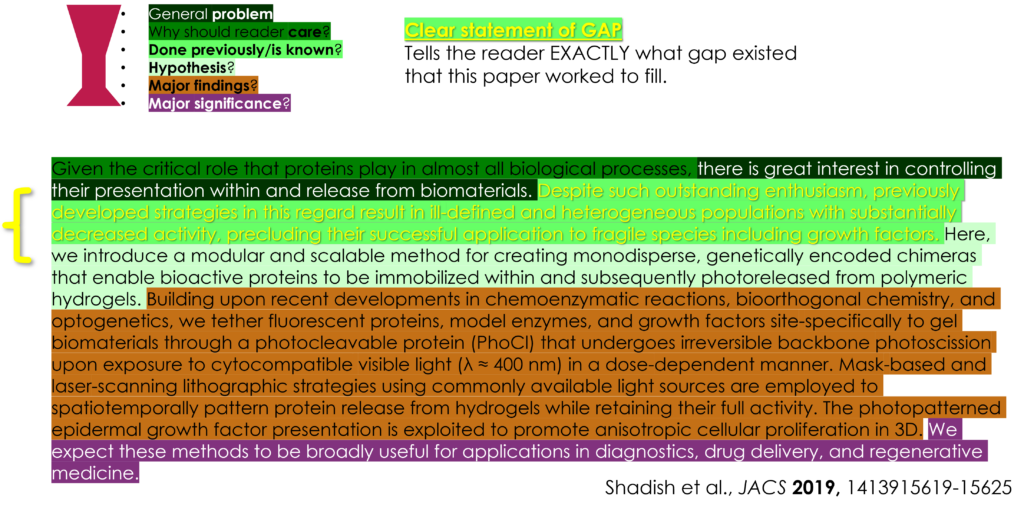
Notice how this is a DIRECT STATEMENT worded like a problem that exists in the field that your work exists to solve.
Now what does it look like if this gap is missing?
Read both abstracts to see the difference here:

Can you now see how missing a direct statement of this abstract makes the reader determine this for themselves? How it makes it hard to see the IMPACT of this work because you cannot see WHY it was necessary?
Clearly articulate this so the reader can properly judge the necessity for your study.
You can do this easily by adding a statement with obvious negative wording, such as “but” or “however“, or direct statements of what info is missing with terminology like “remains unknown“, “remains unexplored“, or “is unclear“.
Abstract mistake #5: Missing statement of gap. If your abstract doesn't directly state the gap in the field that your work exists to solve, how will your reader guess? They won't see why your work is important or necessary!
Kaycie at ButlerSciComm Tweet
6. Start with a definition or explanation
It is common to start an abstract with a definition from or an explanation of the field (its easier to start writing from here!), but this can be isolating for any reader who isn’t an expert in your field.
Notice also how instead of a statement that relates to the reader, a definition or fact from the field makes your problem less obvious (and paper less relatable!):
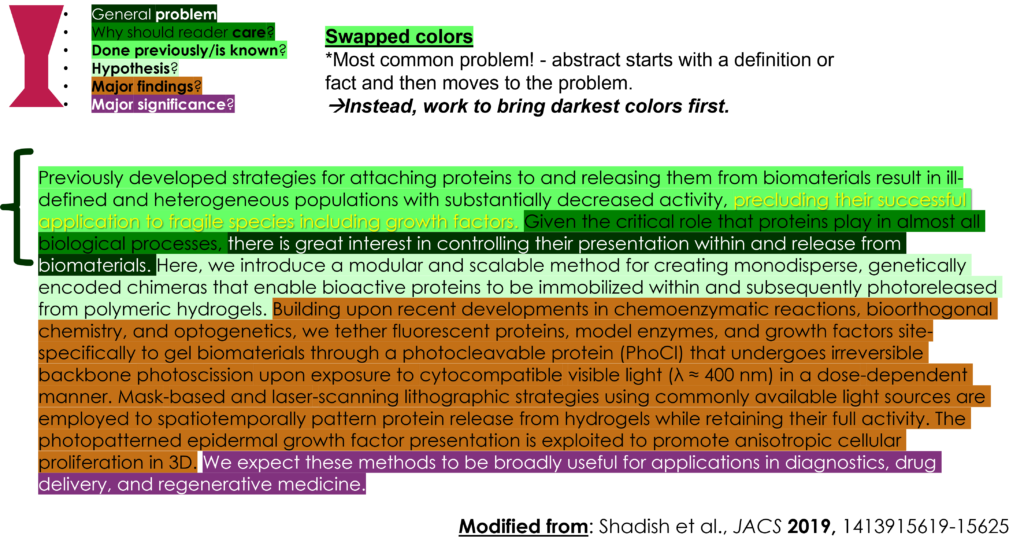
Abstract writing like this masks the importance and makes it less relatable.
With these papers, if you aren’t an expert in this field, you don’t get much further than the first sentence.
Instead, always start by relating to the reader and only then bring in any necessary definitions or descriptions from the field.
Abstract Mistake #6: Starting with a field-specific definition (instead of a problem that relates to your reader) masks the importance of your work and makes it less relatable! Non-experts will probably give it a skip!
Kaycie at ButlerSciComm Tweet
Want more abstract writing?
Check out this post and video fully breaking down this abstract into the key points, why they matter, and where they go to have the biggest impact on your paper.
So what mistakes were you making?
…and what did you do to FIX them now?
What abstract writing mistakes did I miss?
Let us know in the comments!

